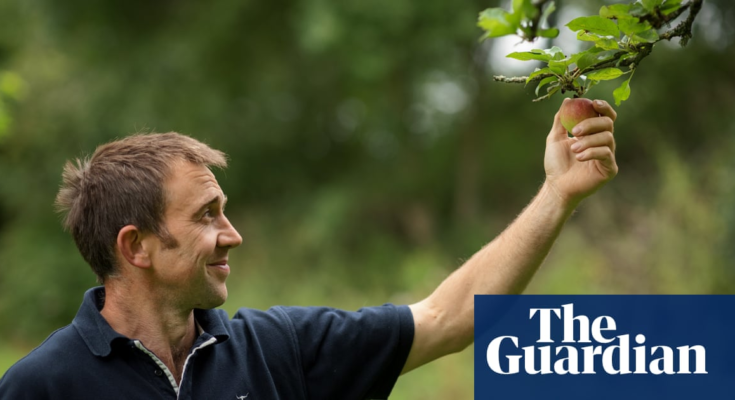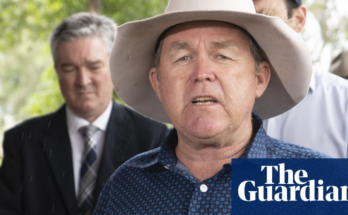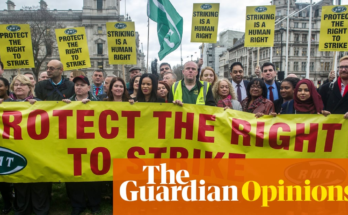The coming revolution in subsidies is driving interest that could help the climate and biodiversity
“My farming friends think I’m nuts – I can’t remember when that hedge was cut last,” says Richard Thomas. Cutting is usually an annual event, but the bushy, 3-metre-wide hedgerow is now home to yellowhammers, his favourite birds.
Thomas has laid about a kilometre of hedgerows in the past few years on his 250-hectare (617-acre) cattle and sheep farm in Herefordshire, where his family have farmed since 1893. But he would like to do more and hopes the fast-approaching revolution in the government’s use of the £3bn a year in farming subsidies is going to help.
Thomas is one of 200 farmers taking part in a National Farmers Union’ programme to explore how the government’s aim of paying “public money for public goods” translates into action on the ground. Before Brexit, subsidies were largely based on simply how much land a farmer owned or rented. Over the next seven years, the goal is to switch the money to boosting wildlife, reducing floods and, crucially, storing the carbon emissions driving the climate crisis in soils and trees.
Thomas moves his livestock every day or two to allow pastures to naturally recover without adding chemical fertiliser, which is made from fossil gas and is big source of emissions. In the 30 hectares of century-old apple orchards on the farm, the cows graze between the trees.
“It’s been happening since the dawn of time – animals and trees. It’s symbiotic,” says Thomas. The trees are 10 metres apart, a much larger gap than on most apple farms. “I am not anti-monoculture, but because our trees are not close together, we get a lot less pests – look at the air going between the trees,” Thomas says. He says he doesn’t use pesticides on the cider apples and he has not bought fertiliser for his pasture this year.
Thomas says this more natural form of agriculture will not suit all farmers, many of whom are used to intensive farming: “If you’re a tenanted farmer, you’ve got a high rent, and you need to pay the bills, then you need to do what you need to do to make ends meet.
“But there is a point in time where we will have no choice to change the way we live now, because the planet’s already having problems,” Thomas says. “So why not start now?” He is cautious about saying he is practising regenerative farming already – producing food while restoring the land. “But we’re certainly on that track.”
Farming in the UK is at crossroads, as the climate and wildlife crises worsen, with competing visions of the future. The NFU’s plan for net-zero emissions by 2040 does not involve cutting beef production or converting large areas of farmland into forest. Instead, it says, three-quarters of the UK’s agricultural emissions can be offset by growing fuel for power stations and then capturing and burying the carbon dioxide.
In contrast, Prof Ian Boyd, former chief scientist at the Department for Environment, Food and Rural Affairs (Defra), has said half of the nation’s farmland needs to be transformed into woodlands and farmers were potentially “sitting on a goldmine” in terms of the payments they could receive capturing carbon in trees.
Either way, farmers say they are up for the challenge, according to a new NFU survey of 400 randomly chosen members. It found that 84% of farmers were interested in applying for the environmental land management schemes (ELMs) that the government will use to channel public money into public goods.
“This is work farmers really want to do,” says the NFU’s vice-president Tom Bradshaw. He has a 1,000-hectare arable farm in Essex and is signing up for Defra’s first ELM pilots, due to begin in 2022. He expects to use 8% of the land he farms to support biodiversity.
The NFU survey found farmers keen to include carbon-cutting measures alongside wildlife and water actions. Most popular was hedgerow restoration, with 89% support, followed by improved grassland and fertiliser management. Least attractive, though still with 60% support, was changing livestock feeds to curb the methane emissions that are the biggest part of agriculture’s greenhouse gas emissions.
Planting trees and agroforestry was backed by 70% of members, and Thomas agrees with them. He is planning, with support from the Woodland Trust, to plant walnut and hazelnut trees alongside apples in a 12-hectare area that is currently grassland. “I won’t see the benefit of that, but it’s something for the next generation,” he says. “Though the squirrels will try to eat all the nuts, so we’ll need to conquer that somehow.”
Thomas says his epiphany came three years ago, after reading books including Dirt – the Erosion of Previous Civilisations, by David Montgomery. “[Many ancient societies] stuffed the soil and ran out of food, and we are in danger of doing that. We need to let the biological system do its thing.”
More natural farming cuts costs, Thomas says. He points out chicory, plantain, red clover and bird’s-foot trefoil in the herbal leys that his ewes and lambs are grazing on. They have fewer worm infestations, he says, as they don’t need to crop grass right down to the soil. For the cows, more outdoor grazing cuts the expense of winter housing and feeding. Most livestock farms are not profitable without subsidies, he notes wryly.
“Changing practices is a bit of a leap of faith at times,” he says. Yields might be a bit lower, but the cost of the inputs also goes down, pushing profits up, and he quotes an old farming friend of his father’s: “It’s not what you make, boy, it’s what you keep”.
“A lot of people are transitioning,” Thomas says. “Some of it’s driven by just wanting to do the right thing and some of it’s driven by economics: tractors are getting more expensive, diesel’s getting more expensive, nitrogen is £365 a tonne this week. But maybe the government can accelerate it.”
On their 2,500-hectare cattle and sheep farm in the Peak District, Richard and Jill Cottrill hope so. “We’ve planted trees and sphagnum moss to sequester more carbon, as well as running a regeneration project on our moor,” says Richard. “However, if these actions were supported through ELMs, I would be in a much better position to increase the scale of this work. I also believe there are huge opportunities for businesses like mine when it comes to selling carbon credits.”
With ministers wanting 70% of farmers taking up ELM schemes, the economics will be crucial, says Bradshaw. “We run rural businesses, and if the economics work for delivering public goods for public money, then we will very happily do it. But at the moment, I think it’s questionable.” For example, he says, the proposed payment for leaving a 6-metre buffer zone along river banks to reduce water pollution does not appear to cover the lost income from crops.
“If the environment is not going to be paying the cost, someone needs to pay, and we can’t lose the significance of producing food either,” says Thomas. “I think there’s a massive arrogance from the people who stand up in parliament saying, ‘Don’t worry, we’ll import all the food you want.’ It will probably get very difficult if we have rewilded everything and don’t grow anything.
“I’m not asking to be a millionaire. I just want to improve my asset – the soil – and stay in business.”
{{topLeft}}
{{bottomLeft}}
{{topRight}}
{{bottomRight}}
{{/ticker}}
{{heading}}
{{#paragraphs}}
{{.}}
{{/paragraphs}}{{highlightedText}}



